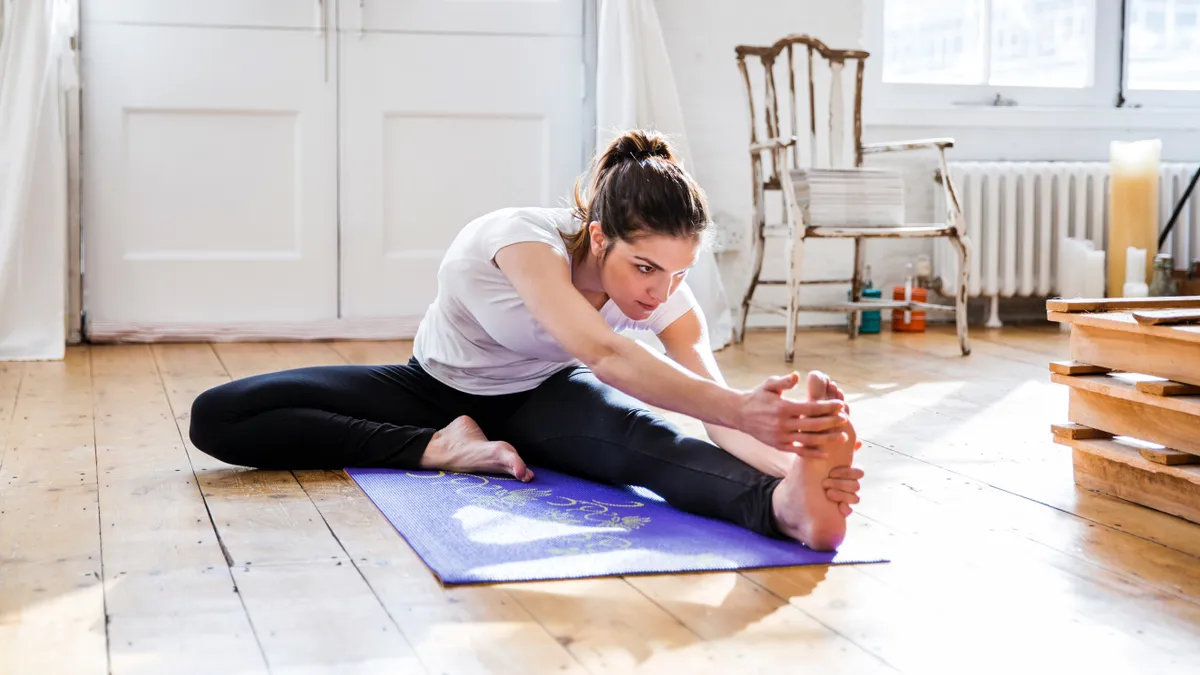Cyclists, especially those training regularly, may be renowned for their supreme cardiovascular fitness, phenomenal power output and colossal thighs, but when it comes to flexibility, it has to be said that most of us are decidedly lacking.
It’s not surprising when you consider what riding a bike entails. “It’s a repetitive action performed through a limited range of motion, which means that the legs are neither fully extended nor fully flexed,” explains Rebecca Bogue, a yoga teacher who runs Yoga for Cyclists classes. “Joints are never taken through their full range of motion.”
To compound the problem, cycling is one of the few activities in which muscles contract only concentrically (while shortening) and not eccentrically (while lengthening) and over time, this can result in what’s known as ‘adaptive shortening’, the process by which muscle fibres physically shorten. But does it matter? Well, it depends who you ask.
Scientists still hotly debate the topic of whether stretching is beneficial for athletes, detrimental or makes no difference either way. Research on runners, published in the Journal of Strength and Conditioning, found that those who performed the worst in a ‘sit and reach’ test (a measure of hamstring and lower back flexibility) had the greatest running economy, a measure that could be described as their ‘miles per gallon’ rate.
The theory is that tight leg, hip and trunk musculature increases elastic energy return. But there’s a major reason why the same may not apply on a bike. “Riding a bike is not something that we evolved to do,” says Mark Simpson, former lead strength and conditioning coach at the English Institute of Sport, who worked with the British Cycling team. “It’s not a natural movement like running or walking, and is therefore more likely to cause muscular imbalances and postural changes.”
Poor flexibility doesn’t just give you bad posture and hike up your injury risk, your cycling performance is at stake, too
As an example, the forward-leaning, crouched position adopted by roadies and track cyclists tends to make the hip flexors tighten and shorten (“every cyclist I know has hip flexor tightness,” says Simpson) causing an anterior pelvic tilt and an excessively arched lower back.
“Postural changes like this can lead to chronic problems such as lower back pain that will affect your daily activities, not to mention your riding, in the long-term,” he adds. Bogue agrees. “If muscles get tight, they pull on bones and put things out of alignment, increasing the risk of pain, discomfort and injury,” she says.
But poor flexibility — and its consequences — don’t just give you bad posture and hike up your injury risk, your cycling performance is at stake, too. “You need a good range of motion in the hips and lower back to achieve an aerodynamic time-trial position,” says Graham Anderson, a physiotherapist who has worked with everyone from Olympic cyclists to weekend warriors.
“Without it, your power output will be reduced because you won’t be able to get maximal force from the gluteal muscles. What’s more, if you have a stiff lower back, you’ll typically overreach with the arms, putting too much weight on the hands and causing tightness across the upper back and neck.”
For Simpson, who worked mainly with BMXers and sprint cyclists, flexibility is also important for cross-training. “To perform a squat, for example, you need good ankle, knee and hip flexibility,” he explains. “If the ankle joint is tight, it puts too much pressure on the knee.” And if you participate in other sports, or compete in triathlon, stiff, tight muscles are not going to do your running stride or swim stroke any favours.
While you may not need to be able to wrap your feet around your shoulders or bend over backwards to ride your bike, you do need to maintain — or, more likely, regain — what Simpson calls ‘normal’ range of motion in the joints, in order to ride comfortably and efficiently — and to be able to adapt your riding position where necessary.
You also need to consider the joints and muscles that cycling doesn’t use. “In cycling, you’re only moving your joints in a straight line — there’s no other plane of motion, such as rotational or lateral movement,” explains Anderson. “It’s important to take your joints through these neglected ranges, too, otherwise flexibility will diminish.”
While Anderson believes there is no single ‘recipe’ for optimal flexibility that suits everyone, in Bogue’s experience there are some key areas to address. “The areas which are tight in cyclists are so universal I can practically tick the boxes,” she says. Stiff quads, hip flexors, hamstrings and lower backs are top of the list, accompanied by tight ‘closed’ shoulders and chest muscles.
So what do we do to redress the balance? “The key thing is to reverse the cycle posture,” she says. “For example, stretches which extend the lower back are a great antidote to the flexed, forward-leaning position on the bike.”
A cyclist herself, Bogue has experienced the stiffness and tightness that can result from hours in the saddle, and believes yoga is the perfect complement. “It’s a way of elongating the muscles, but also it enhances your body awareness, so you notice what feels tight or stiff — and know what to do to alleviate it.”
Stretching Q&A
When should I stretch? Before a ride is not the best time to stretch: your muscles are cold, making them more susceptible to injury, plus static stretching (in which you hold a fixed position) can reduce power output for up to an hour. Instead, include some ‘dynamic’ stretching in your warm-up to prepare your muscles. “Take your joints through movements that replicate the range of motion you’ll be using,” advises Anderson.
Bogue recommends the ‘Sun Salutation’ series from yoga. “It warms up the muscles as well as stretching and strengthening them,” she says. After a ride — or as a stand-alone session after warming up — use static stretching to help restore muscles to their ‘resting’ length, or to develop length in shortened muscles.
How long should I stretch for? You need to allow time for the ‘stretch response’ to take place, which occurs once the muscle relaxes and stops trying to protect itself from the stretch. Aim for at least 20 seconds, but 60 or more to increase flexibility.
How many stretches should I do? The American College of Sports Medicine (ACSM) recommends performing each stretch two to four times.
How far should I stretch? “It shouldn’t be painful but there should be a little discomfort and tension,” says Anderson.
How often should I stretch? ACSM advises flexibility training two or three times per week.
Common stretches and yoga poses ideal for cyclists
1. Calf stretch into a wall

After a gentle warm-up, start the sequence with this stretch/yoga pose favoured by runners and used in numerous disciplines. Stand facing a wall with toes pointing forward. Place your hands flat against the wall at shoulder height. Bring one leg behind you (around half a metre) then place the foot flat on the floor (making sure your toes are still pointed straight forward).
Slowly lean forward over your front leg, but keep your back knee straight and your heel flat on the floor. You should feel this stretch in the big muscle of your calf (gastrocnemius). If you then bend your back knee slightly (keeping the foot flat on the floor) the stretch should be felt lower down your calf (soleus). Hold for at least 15 seconds. Switch legs and repeat.
2. Downward facing dog (Adho Mukha Svanasana)
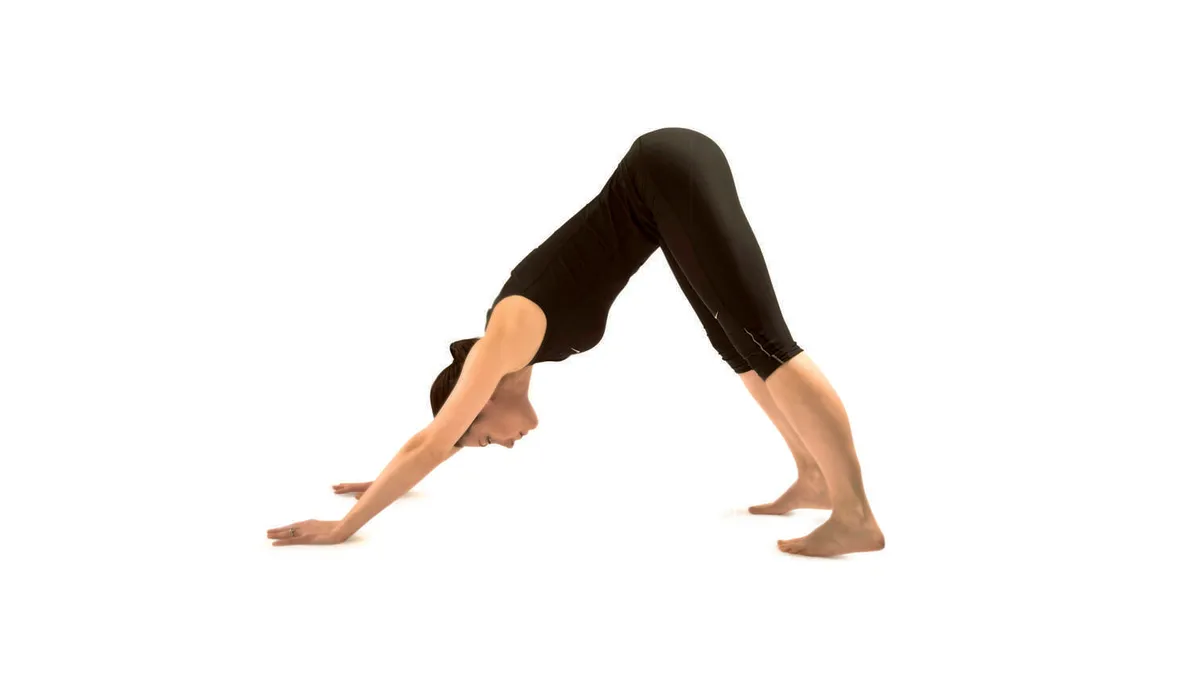
A great all-in-one that elongates and releases tension throughout the entire spinal column, opens the hips and stretches the back of the legs. If your hamstrings are particularly tight, step the feet wider apart in all variations and/or bend the knees slightly. The heels can also be placed against a wall. Begin on all fours with your hands slightly in front of the shoulders on the floor and toes tucked forwards.
On an exhalation, keeping your toes tucked under, lift your knees from the floor, straightening your legs and raising your bottom while moving onto the soles of your feet and working to press your heels into the floor. Push through the shoulders so the bottom is pushed back and the stretch can be felt through the back and hamstrings. Repeat a few times. Take at least five breaths.
3. Expanded leg pose (Prasarita Padottanasana)

Begin with your feet very wide apart (the wider apart the feet, the easier it will be on the hamstrings). Placing your hands on your hips, inhale deeply and then bend forward on the exhale, bringing the torso only as far down as you can while maintaining a long spine. If your hamstrings are particularly tight, the knees can be bent slightly, releasing any tension in your back.
Variation A: Place your hands on a pile of books placed below shoulder level. Work towards eventually placing your hands in between the feet.
Variation B: Interlace your fingers behind your back and fold your torso over, allowing the arms to come overhead. A belt held between your hands can be used if your shoulders and arms are initially too tight to yield.
4. Quad stretch

This is one of many preparatory stretches for back-bends — the ultimate cycle posture reversal. This stretch focuses on the quadriceps and hip flexors and eventually the spine, as well as opening the chest and shoulder muscles. Start on all fours with the soles of your feet against a wall. Place a blanket underneath the knees if this is uncomfortable. Take your right knee off the floor and place it against the wall with your toes pointing upwards on the wall and your shin against the wall.
Slide your knee down towards the floor, making sure that the shin and knee are in contact with the wall at all times. Re-arrange the left leg so that the sole of the foot is now on the floor. The left shin and thigh should be making a 90-degree angle. Take at least five breaths. This is an intense stretch. Gradually take your hands off the floor and on an inhale, place your hands lightly on your left knee.
5. Camel pose (Ustrasana)
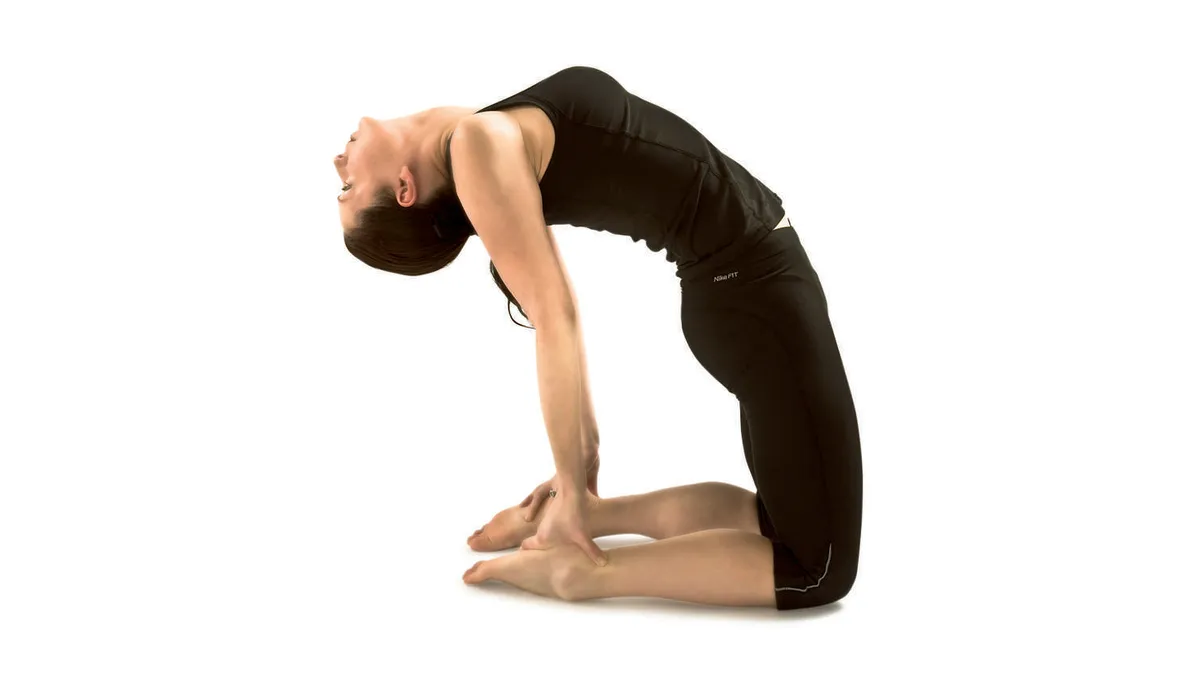
This yoga pose opens the groin, thighs and entire back, as well as stretching the muscles in the chest, the front of the shoulders and back of the neck. With the soles of your feet against the wall and your toes tucked under, sit in a kneeling position. Slowly rise up off your heels, bringing the thighs and torso upright.
Inhale and gradually move your back into an arc on the exhale until the back of your head makes contact with the wall. Bring your hands towards your heels. If you can’t reach them, you can place a pile of thick books on either side of your shins and reach those. Take at least five breaths.
6. Seated glute stretch and hip opener
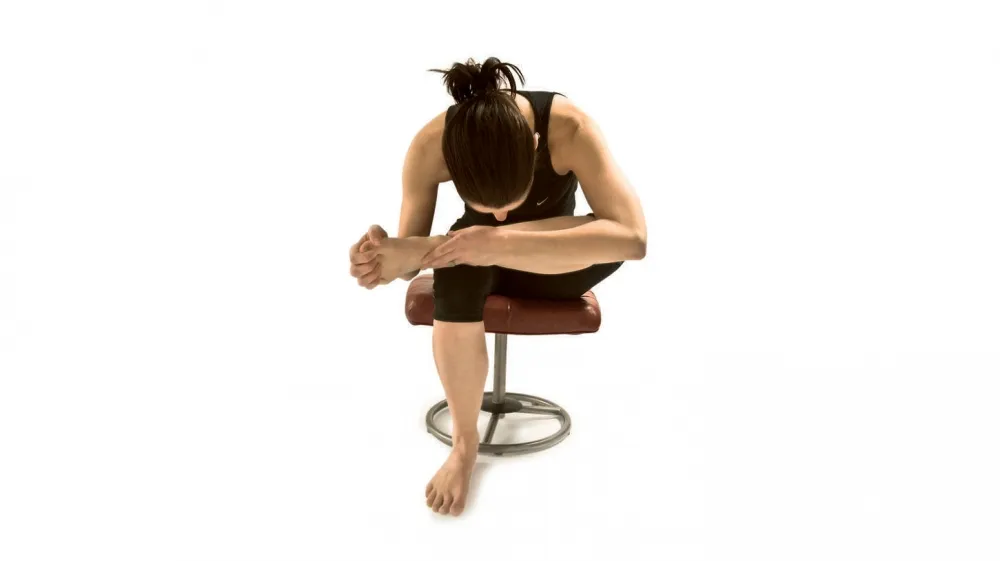
This step in the sequence provides a deep stretch in the glutes and opens the hips. Sitting on a chair, have the sole of the right foot on the floor in line with the right knee. Place your left ankle on and just beyond the right knee. Keeping the spine as long as possible, inhale then fold at the hips on the exhale, bringing your torso over your left shin.
Take at least five breaths. As you relax into the stretch you may eventually be able to place both forearms on the legs. The right forearm rests on the inside of the left foot while the left forearm is placed at the front of the right knee (over the left foot).
7. Revolved belly pose (Athara Parivartanasana)
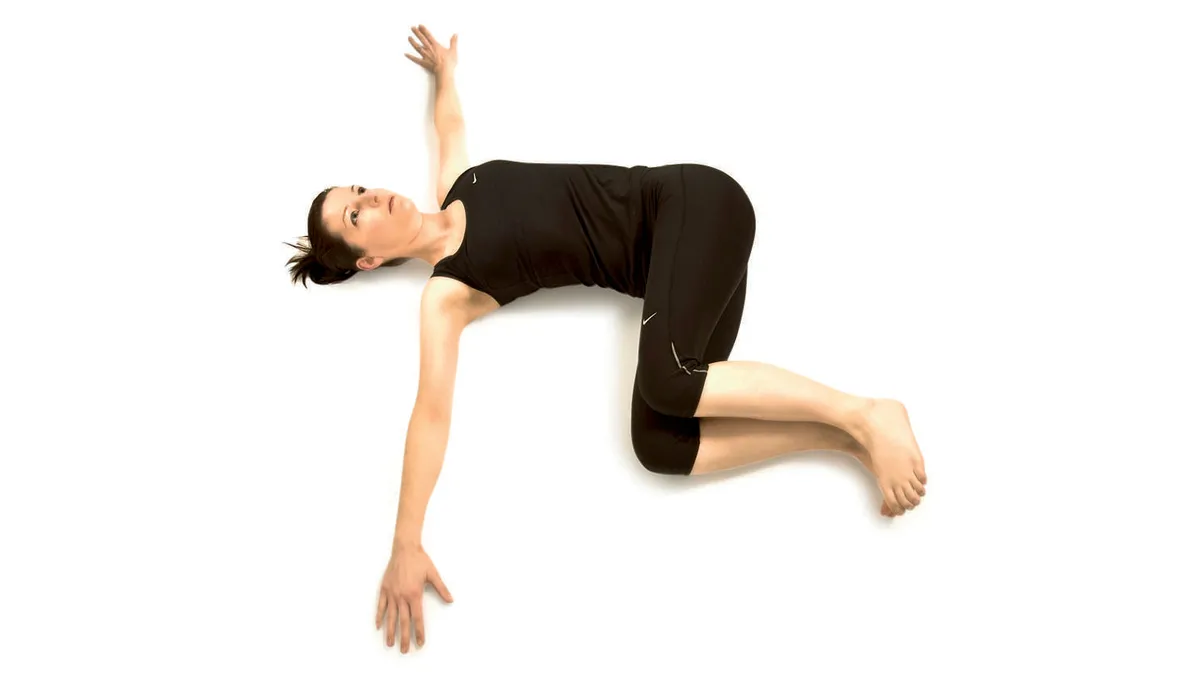
This is a good stretch for those with particularly stiff backs. It releases tension in the spinal column, hips and shoulders and relieves discomfort in the lumbar spine. Lying on your back with your knees bent, bring them into your chest. Inhale and, with the next exhalation, roll your knees to the right side and rest them on a pillow.
Stretch both arms outwards along the floor to open the space between the shoulder blades then, as the lower back gradually releases, straighten the legs out slowly, aiming to eventually have your toes touch the hand nearest them.
8. Supported bound angle pose (Salamba Supta Baddha Khonasana)

This yoga stretch helps alleviate most cyclists’ complaint zones. It’s a completely passive stretch and can be held for as long as you like and, best of all, it feels great.
Sit on the floor directly in front of the end of a bolster (or a few folded blankets), and bring the soles of the feet together so that your legs form a diamond shape. Reclining on your elbows, lie back onto the bolster and stay like that for 5–10 minutes. This stretch releases tension in the diaphragm, chest and shoulders, and the groin and hips.
Article last updated 18 January 2018
